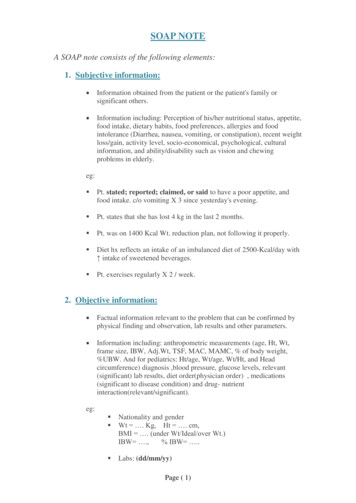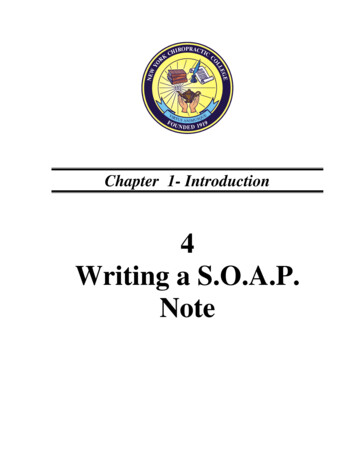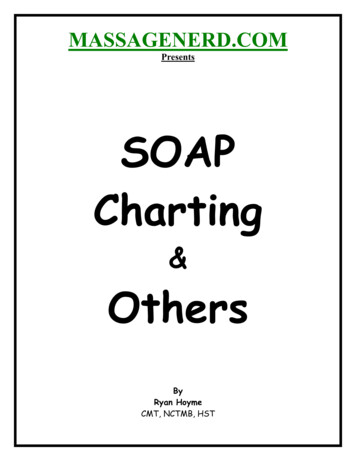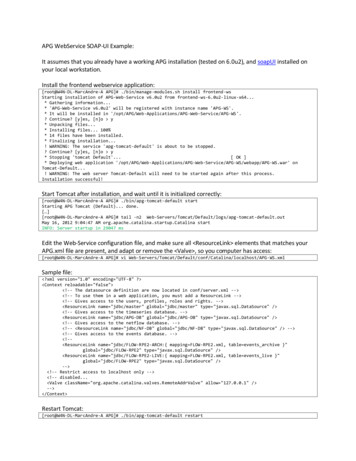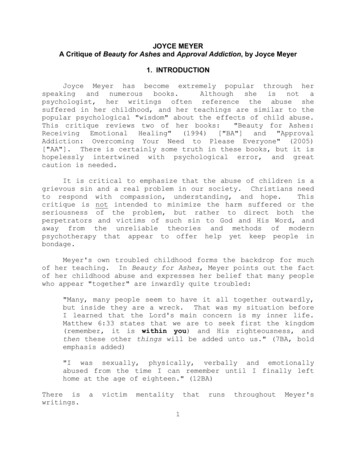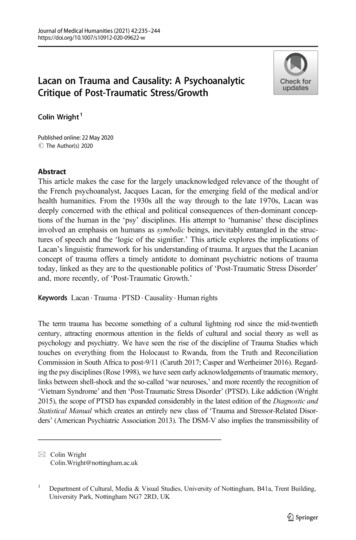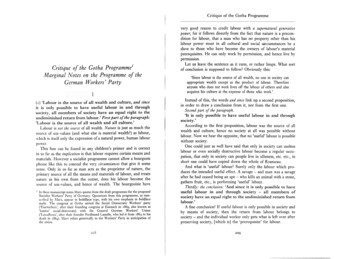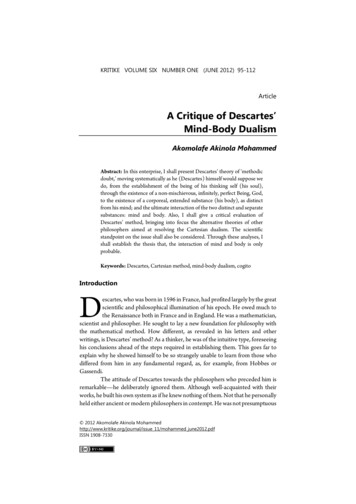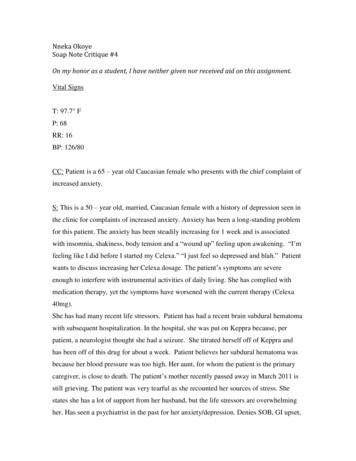
Transcription
Nneka OkoyeSoap Note Critique #4On my honor as a student, I have neither given nor received aid on this assignment.Vital SignsT: 97.7 FP: 68RR: 16BP: 126/80CC: Patient is a 65 – year old Caucasian female who presents with the chief complaint ofincreased anxiety.S: This is a 50 – year old, married, Caucasian female with a history of depression seen inthe clinic for complaints of increased anxiety. Anxiety has been a long-standing problemfor this patient. The anxiety has been steadily increasing for 1 week and is associatedwith insomnia, shakiness, body tension and a “wound up” feeling upon awakening. “I’mfeeling like I did before I started my Celexa.” “I just feel so depressed and blah.” Patientwants to discuss increasing her Celexa dosage. The patient’s symptoms are severeenough to interfere with instrumental activities of daily living. She has complied withmedication therapy, yet the symptoms have worsened with the current therapy (Celexa40mg).She has had many recent life stressors. Patient has had a recent brain subdural hematomawith subsequent hospitalization. In the hospital, she was put on Keppra because, perpatient, a neurologist thought she had a seizure. She titrated herself off of Keppra andhas been off of this drug for about a week. Patient believes her subdural hematoma wasbecause her blood pressure was too high. Her aunt, for whom the patient is the primarycaregiver, is close to death. The patient’s mother recently passed away in March 2011 isstill grieving. The patient was very tearful as she recounted her sources of stress. Shestates she has a lot of support from her husband, but the life stressors are overwhelmingher. Has seen a psychiatrist in the past for her anxiety/depression. Denies SOB, GI upset,
palpitations and fatigue. Patient is positive for muscle aches/tension, insomnia andrestlessness. Negative for night sweats, fever, chills, appetite change or weight change,visual disturbances, epistaxis, sinus congestion/pain, sore throat, post nasal drip, chroniccough, increasing SOB, pleuritic chest pain, orthopnea, ischemic chest pain, palpitations,syncope, dysphagia, reflux or heartburn, abdominal pain, changes in bowel habits orblood/mucous in stool, urinary symptoms and unusual headaches. Never drinks alcoholnor does she smoke.Deletions/Revisions I did not ask how long she was on Celexa nor when she was diagnosed withdepression and anxiety. I should have put ‘patient was diagnosed with anxiety anddepression in 1999 and was started on Celexa in 2004’.o As part of the comprehensive assessment, consider a history of mentalhealth disorders, past experience of, and response to, treatments (NationalCollaborating Center for Mental Health, 2011). I did not ask if her life stressors have caused her to have any suicidal tendencies. Ishould have done a suicide screening and assessed for suicide ideation.o Late in life, suicide may be one consequence of anxiety triggered bytrauma (including crime), illness in the spouse, and bereavement(Allgulander, 2009).o Patients may ruminate about death, feel that life is not worth living, havesuicidal thoughts, make plans or attempt to kill themselves (Rothberg &Schneck, 2011). I should have asked if the patient had a family history of anxietyo Genes can influence health and behavior and it is important to considerfamily members with similar symptoms (Walker - Schmucker, 2008).o Genetic factors appear to play a modest role in the etiology of GAD andrecent research suggests that there is a shared genetic vulnerability toGAD, major depression, and the personality trait of neuroticism. Thetendency of GAD to run in families has also been described as largely dueto genetic features shared with relatives rather than effects of familyenvironment (Ciechanowski & Katon, 2011).
O:GENERAL: Well – developed Caucasian female, afebrile, alert and in no acute distressHEAD/FACE: Symmetric. Normocephalic/Atraumatic.NECK: Neck reveals no carotid bruits, no JVD, and no lymphadenopathy. There is noevidence of thyromegaly.CHEST/LUNG: Chest expansion is symmetrical. Lungs are clear to auscultation andpercussion bilaterally.HEART: Heart has a regular rate and rhythm. Normal S1 and S2.Abdomen: Abdomen is soft, benign, non – tender. Bowel sounds are normoactive. NoCVA tendernessDeletions/Revision: I should have addressed that I did not observe any opthalmopathy (addressespossible hyperthyroid).Diagnostics: No labs were obtained at time of clinic visit. “Diagnostic tests should be guidedby the history and physical examination” (Walker - Schmucker, 2008).Deletions/Revisions: I should have done an anxiety screening. “Screening for anxiety disorders is necessary because a large andgrowing percentage of anxious individuals are now treated inprimary care setting” (Walker - Schmucker, 2008). Due to lack of knowledge about this screening tool, I did not utilize this.Utilizing the GAD – 7 screening tool would have helped me realize how severeher anxiety was. We could have also kept a record of it in the chart and have herscreened again in 3 months to re – evaluate the effectiveness of treatment.o The GAD – 7 tool has been validated to screen for generalized anxiety, aswell as for other types of anxiety (panic disorder, social anxiety disorder,and posttraumatic stress disorder) A score of 10 or greater on the GAD - 7represents a reasonable cut point for identifying cases of GAD with asensitivity of 89 % and specificity of 82 %. Cut points of 5, 10, and 15
have been established as representing mild, moderate, and severe levels ofanxiety on the GAD – 7 (Ciechanowski & Katon, 2011). We should have done a formal suicide screening.oSuicide screening should include assessing current level of depression,severity of symptoms, feelings of hopelessness; current suicidal thoughtsand behaviors (as well as past attempts), use of drugs or alcohol (whichcan increase levels of impulsivity and worsen dysphoria), current levels ofanxiety and agitation, access to lethal means (especially firearms),presence of psychosis (command hallucinations, poor reality testing),recent acute stressors, and presence (or absence) of a psychosocial support system (Rothberg & Schneck, 2011). Based on clinical presentation, it is not imperative to have a TSH drawn.A:Most likely generalized anxiety disorder due to multiple life stressorsDeletions/Revisions:o After performing a literature review, I believe this patient most likely hasAdjustment Disorder with Anxious Mood. Patient has been experiencing increased anxiety in response tomultiple life stressors and it has not persisted for more than 6months. “Many patients have the full constellation of symptoms that meetthe DSM-IV criteria, but have had symptoms for a shorter periodthan the required six months. These individuals often havesymptoms of anxiety as a result of a specific stressor, or symptomsthat occur within three months of the onset of a stressor; they fulfillthe DSM-IV diagnostic criteria for "adjustment disorder withanxious mood" rather than GAD” (Ciechanowski & Katon, 2011).o Major Depressive Disorder (confirmed) “In elderly persons ( 65 years) the prevalence of all anxietydisorders appears to decline, except for GAD, which is maintained
at 4% prevalence and may increase over time” (Rothberg &Schneck, 2011). Major depression and anxiety are often found together. Studieshave consistently shown that anxiety disorders are the mostfrequently occurring co morbid disorder with major depression,with 50% to 60% of major depressed patients with both illnesses(Rothberg & Schneck, 2011). The patient has verbalized feeling depressed and is presenting withdepressive symptoms. Patient also has a history of depression andis on medication for this condition. The essential feature of a major depressive episode is aperiod lasting at least 2 weeks during which the patientexperiences depressed mood or loss of interest or pleasurein almost all activities, a distinct change in usual self, andclinically significant distress or changes in functioning. It isaccompanied by a constellation of other symptoms, such aschanges in sleep, eating, energy, motivation, andconcentration; difficulty making decisions; and oftenfeelings of hopelessness, worthlessness and guilt (Rothberg& Schneck, 2011).o Generalized Anxiety Disorder (refuted) GAD is characterized by excessive worry and anxiety that aredifficult to control and that cause significant distress andimpairment (Ciechanowski & Katon, 2011). The patient has not been experiencing her symptoms more than 6months. Although she does present with 3 out of 6 keys symptomsof GAD (restlessness/nervousness, muscle tension and sleepdisturbance), she has to be experiencing these symptoms for at atleast 6 months.o Acute Situational Anxiety (refuted)
Situational worries are less likely to be accompanied by physicalsymptoms ( American Psychiatric Association, 2000).Restlessness, fatigue and other physical symptoms are rarelypresent.o Medication – induced anxiety (refuted) Almost all classes of antidepressants cause anxiety in somepatients, particularly during the initiation of treatmento Hyperthyroidism (refuted) We needed a TSH level, but did not get one. Patient has noprevious history. Patient denies weight loss, warm moist skin, heatintolerance. No expothalamos or goiter observed.P:Will increase Celexa to 60mg daily which patient states she has used in the past withgood results.Declines any meds for insomniaUtilize relaxation techniques to help reduce stressKeep appointment with osteopathic physician in about 3 weeksWill arrange for counseling/evaluation by psychologistFollow up with clinic in 2 months, sooner if needed for problems or questionsDeletions/Revision:o It is dangerous to increase the Celexa to 60mg. Carol looked up a 2008NPPR book and it said Celexa could be maxed out at 60mg. MyEpocrates said 40mg/daily is the max. Due to increased serum concentrations in patient’s 60 years andthe risk of QT prolongation, the maximum recommended dose inelderly patients is 20 mg/day. Patients with hepatic impairment, 60 years of age, poor CYP2C19 metabolizers, or takingcimetidine should not receive citalopram doses 20 mg/day due tothe potential for increased citalopram serum concentrations (Up ToDate, 2011).
o Celexa is not indicated in generalized anxiety disorder nor does increasingthe dose 40mg help with her depressive symptoms. UpToDate reportsthat it is used for the treatment of depression. Dosages 40 mg/day have not been shown to be more effective intreating depression during clinical trials (UpToDate, 2011).o I would have changed her medication to Lexapro 20mg PO QD since it isin the same class as Celexa and proven to be more efficacious for anxietyand depression. A task force appointed by the World Federation of Societies ofBiological Psychiatry recently updated the treatmentrecommendations for GAD and determined the most efficaciousdrugs were: escitalopram, paroxetine, sertraline, venlafaxine,duloxetine, pregabalin, and quetiapine (Allgulander, 2009).Teaching/Education:Deletions/Revision: We should have discussed with the patient that GAD associated withMDD is a chronic, non - remitting and relapsing disorder. That it is quiteokay to be feeling the she’s feeling given her current situation. We shouldempower the patient and assured her that, with adequate support, she willget through this life hurdle.o A means of improving the care for primary care patients who haveGAD or depression is to provide adjunct psycho - education for thepatient and key relatives, compliance monitoring, and feedback(Allgulander, 2009). Worry management skills and mindfulness meditation encourage greatertolerance for uncertainty (Shearer, 2007).o Educate the patient and family members about treatment options aswell as realistic treatment expectations and reassure them of theabsence of medical causes (Blevins & Goddard, 2011).
We should have discussed the importance of regularly attendingcounseling sessions to understand how to adequately cope with lifestressors and deal with root of her anxiety/depression.o Treating underlying depressive and anxiety disorders not onlyimproves the emotional well-being of patients, but also improvesoverall health outcomes and lowers health care costs (Rothberg &Schneck, 2011).o A combination of psychotherapy and medication management isrecommended in all of the anxiety disorders. Cognitive-behavioraltherapy (CBT) has the strongest empiric support of all thepsychotherapies, but it requires commitment to treatment on thepart of the patient (Blevins & Goddard, 2011). We should have warned her about using over – the – counter medicationslike SAM – E (increased risk of serotonin syndrome), aspirin (increasedbleeding) and dextromethorphan (increased risk of serotonin syndrome).o Discuss the use of over-the-counter medications and preparationswith people with GAD and explain the potential for interactionswith other prescribed and over-the-counter medications (NationalCollaborating Center for Mental Health, 2011). Physical activity can be adjunctive treatment in GAD.o “Preliminary evidence suggests that exercise reduces anxietysensitivity and may reduce generalized anxiety, yet clinicalimplications of this limited data is to be determined” (Bystritsky,2011).Follow Up Plan Follow up in clinic in 2 months, sooner if needed for problems or questions.CPT code (99214) Office Output Estimated 25 minutes, Office or other outpatient visit forthe evaluation and management of an established patient, which requires at least 2of these three components: A detailed history; A detailed examination; Medical
decision making of moderate complexity. Counseling and/or coordination of carewith other providers or agencies are provided consistent with the nature of theproblem (s) and the patient’s and/or family need (s). Usually, the presentingproblem (s) are of moderate to high severity (Epocrates, 2009).ICD – 9 Code Anxiety (272.4)
ReferencesAllgulander,
Soap Note Critique #4 On my honor as a student, I have neither given nor received aid on this assignment. Vital Signs T: 97.7 F P: 68 RR: 16 BP: 126/80 CC: Patient is a 65 – year old Caucasian female who presents with the chief complaint of increased anxiety. S: This is a 50 – year old, married, Caucasian female with a history of depression seen in the clinic for complaints of increased .
